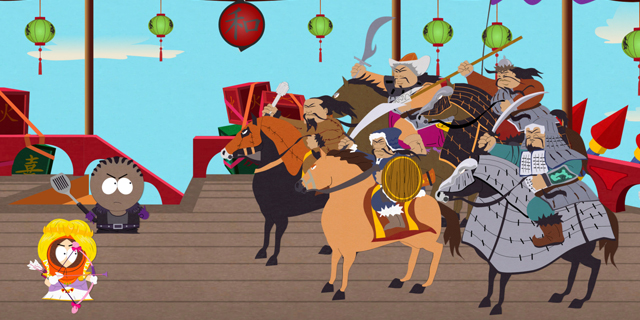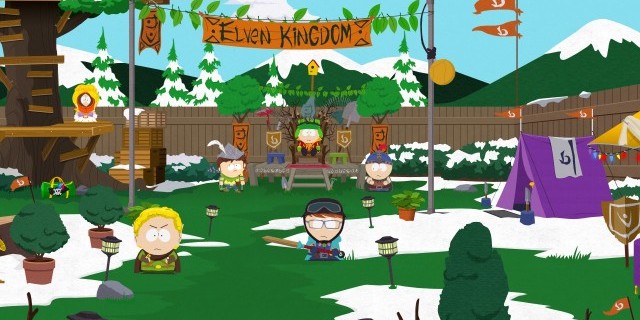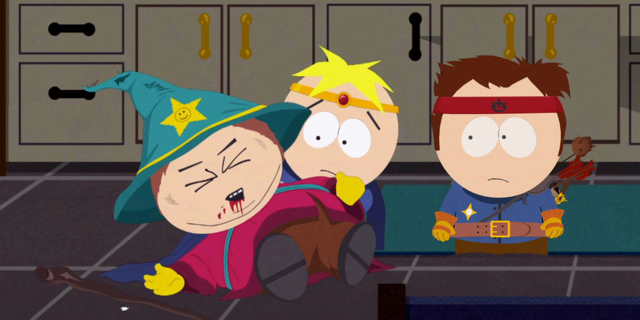
South Park: The Stick of Truth is meant as an earnest effort by South Park Digital Studios and Obsidian Entertainment to make a game that truly embraces the license of the show. This has certainly been a problem in the past, as the South Park name has been slapped on all manner of horrible things since the series began its run. In this aspect, Stick of Truth is a resounding success: it doesn’t just feel like it’s faithful to the South Park name, it feels like an interactive, especially-long episode of South Park.
It accomplishes this through a meticulously-crafted aesthetic. Everything’s drawn and animated exactly as “badly” as the show, and nothing through the entire adventure feels out-of-place. This game is going to age quite well as a result, and it really lets you settle down and enjoy yourself in the world. It’s also a blast to just walk around the town as you know it, as a character of your own creation, and just spend some time here.
The writing is also just what you’d expect. That’s going to turn off those who find the show offensive, a large group that’s quite justified in its position, as Stick of Truth doesn’t shy away from the worst sorts of South Park humor. Conversely, those who are fans of the show wouldn’t have it any other way, and they’ll be happy to learn that it matches some of the series’ best episodes in terms of satire and comic timing. The battleground is the swing vote, the player who likes South Park sometimes but isn’t a devoted fan. And Stick of Truth does what it should to win over those people.

While it’s unabashedly South Park, there’s definitely some of that signature Obsidian RPG styling in here too. Character customization is deep but also funny, with weird and bizarre weapons and equipment bearing legitimate stat differences and strategy. At the beginning of the game, you’ll pick one of four classes and stick to your decision throughout, but there’s enough variety to keep that sort of thing fresh. You’ll unlock perks and “magic” abilities, as well as gain access to different partner characters to swap in and out as needed. (For example, since you’re children playing a game, Butters is a “paladin” with a special healing ability: patting you on the shoulder and telling you everything is going to be okay.)
Battles play out in a way reminiscent of games like Paper Mario and Costume Quest: you’ll choose your action in a radial menu system, then augment your damage with stick movements and button presses as needed. Taking down enemies is largely a matter of taking into account shields, elemental weaknesses and formation; special attacks and equipped weapons have different attributes in these areas, so it’s good to make sure that, for example, your ranged weapon behaves differently from your melee strike. After battles, you loot fallen enemies for cash and series in-joke junk items to sell.
Overworld control feels a lot like Paper Mario, too, and not just because of the two-dimensional aesthetic. You’ll interact with the environment through various acquired abilities and partner talents; for example, a puzzle may need you to shoot an item off a shelf, or for you to bring out Jimmy to let you through special building entrances. You can sometimes use environmental effects to take out enemies outside of battle, and they still count for loot and experience. This is sometimes more satisfying than combat, and a clever use of the sorts of items that would normally be pure scenery.

In some ways, Stick of Truth‘s RPG mechanics hold together so well precisely because the game never takes itself seriously. After all, the last thing you need in South Park is narrative justification. It uses tropes effectively and sends them up at the same time, and it plays with the idea of cutscenes and menus in a very clever way. It’s clear that all involved know the medium very well, so it’s geared toward those of us that groan at the idea of audiologs or fetch quests.
You should also know that it’s not afraid to make the player uncomfortable in the name of humor. It’s gotten some attention for some of its more controversial scenes, but what’s most controversial isn’t the content: it’s putting you in control of some truly bizarre things and making them quick-time events. Again, if you’re easily offended, this isn’t the game for you. There are also quick-time events associated with things like stuttering and pooping, and these are turned into actually-useful game mechanics. This is the game you’re playing.
Progression in the game is largely tied to making Facebook friends. Some minor characters you just walk up to and befriend, but party members and key NPCs have loyalty missions of sorts: help them with a minor quest and gain their social media approval. It’s also a way to inject more jokes without too much more work: characters post things and others respond and like them. Friends aren’t the only thing you collect: you also snag Chinpokomon scattered and hidden around the environment, and you can also search far and wide for special items and equipment.

There’s not exactly much to do after the completion of the game’s adventure, but it will take most between 12 and 15 hours to experience all that a playthrough has to offer. There are a few story choices to make, and you can always try another class, but most of your enjoyment is going to be with that first time through, as jokes just aren’t as funny the second time around. Still, it continues to be rare for a RPG to not overstay its welcome, and Stick of Truth finishes up before it just starts making you mad.
Obsidian and the South Park team accomplish what they set out to do with The Stick of Truth: make a game so reminiscent of the source material that it’s largely indistinguishable. It doesn’t pull any punches in the name of palatability, and it doesn’t make too many design mistakes along the way either. It’s by far the best South Park game, and a viable experience in its own right for those who aren’t rabid fans of the property.
Pros: Faithful recreation of South Park‘s world, amusing customization, successful parody of game tropes
Cons: It’s just as offensive as the show, which some just won’t like



















